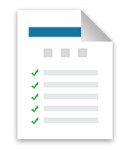The full paediatric BLS sequence is for healthcare professionals with a duty to respond to paediatric emergencies (e.g. Emergency Department staff, paediatric doctors and nurses, paramedics).These people usually work in teams of two or more rescuers.
Lay people with responsibility for the care of children (e.g. teachers, lifeguards) should be taught the adult sequence with the paediatric modifiers (see note below). It is recognised, however, that there are other potential rescuers that fall between these two groups, where it is unclear which sequence is the more appropriate. The decision as to what should be taught may be made locally (e.g. by the Resuscitation Committee) according to circumstances and available resources. In coming to a decision, it may be helpful to ask the following questions:
- Are the providers healthcare professionals?
- Would they normally be expected to have to resuscitate an infant or child during the course of their work?
- Do they usually work in a team?
Generally, the full paediatric sequence and compression: ventilation ratio of 15:2 should be taught to those who give a positive answer to all three questions.
General practitioners, health visitors, and school nurses, for example, are healthcare professionals working with children, but they often work alone. Although they may have to resuscitate a child, this would be a very unusual event and they are more likely to have to resuscitate a parent or grandparent. It would be sufficient to teach these groups the adult sequence of 30:2 with the paediatric modifiers unless they expressed a particular wish or interest to learn the full paediatric sequence.
Mental Health nurses working in child mental health units are healthcare professionals working in teams of two or more. Although it would be unusual in most such units to have to resuscitate a child, some may treat high-risk children (such as those with severe anorexia nervosa) so it would be reasonable to allow training decisions to be based on local circumstances.
Note
Modifications to the adult BLS sequence of 30 compressions: 2 ventilations that will make it more suitable for use on children: - Give 5 initial breaths before starting chest compression.
- If on your own, perform CPR for approximately 1 minute before going for help.
- Compress the chest by one-third of its depth, approximately 4 cm for an infant and approximately 5 cm for an older child. Use two fingers for an infant under 1 year; use one or two hands for a child over 1 year to achieve an adequate depth of compression.
October 2015 

